The Impact of Aerodynamics on Car Performance
Aerodynamics is vital in shaping the performance of modern vehicles. By grasping its definition and fundamental principles, you set the groundwork for appreciating its significance in the automotive industry.
From refining car design to optimizing performance, aerodynamics directly influences how effectively your vehicle slices through the air.
This article will explore the key factors affecting car performance, strategies for improvement, and the testing methods manufacturers employ to ensure their vehicles are as aerodynamic as possible.
Get ready to explore the fascinating world of aerodynamics and see how it impacts performance!
Contents
- Key Takeaways:
- Understanding Aerodynamics
- Aerodynamics in the Automotive Industry
- How Aerodynamics Affects Car Performance
- Improving Aerodynamics for Better Performance
- Measuring and Testing Aerodynamic Performance
- Frequently Asked Questions
- How Does Aerodynamics Affect a Car’s Performance?
- What Are Some Examples of Aerodynamic Features on Cars?
- How Does Aerodynamics Contribute to a Car’s Speed?
- Can Aerodynamics Impact a Car’s Handling?
- What Role Does Aerodynamics Play in Fuel Efficiency?
- How Do Car Manufacturers Incorporate Aerodynamics into Their Designs?
Key Takeaways:

- Aerodynamics is the study of how air flows around objects and is crucial in the design and performance of cars.
- Aerodynamics plays a significant role in the automotive industry, impacting everything from fuel efficiency to handling and speed.
- To improve car performance, manufacturers use various techniques such as reducing drag and increasing downforce, along with extensive testing to measure a car’s aerodynamic performance.
Understanding Aerodynamics
Aerodynamics is the fascinating branch of physics that explores how air behaves as it interacts with solid objects, such as high-performance vehicles like the Bugatti Veyron and cutting-edge electric models like the Tesla Model S.
This field is essential in engineering and design, impacting critical elements such as aerodynamic forces, airflow patterns, and air density. Understanding these factors is key to optimizing vehicle speed and performance, allowing you to appreciate the meticulous science behind automotive excellence.
Definition and Basic Principles
The fundamental principles of aerodynamics center around your understanding of how airflow behaves over surfaces. This encompasses critical elements like lift and turbulence that play a pivotal role in designing high-performance vehicles.
By analyzing how these forces interact with a vehicle’s shape, you can optimize lift an essential force that enables aircraft and certain racing cars to ascend and maintain stability while minimizing drag, which is the resistance that hinders speed.
Turbulence, that chaotic flow of air often provoked by surface roughness or abrupt changes in shape, can increase drag and diminish efficiency. For example, sports cars are meticulously designed with sleek, streamlined bodies to enhance airflow and maximize speed, highlighting the interconnected nature of these aerodynamic principles.
Ultimately, a thorough grasp and application of these concepts can significantly elevate your vehicle’s performance metrics.
Aerodynamics in the Automotive Industry
In the automotive industry, understanding the intricacies of aerodynamics is essential for elevating vehicle performance. This understanding directly impacts drag and the drag coefficient of various models, whether they are road cars or electric vehicles.
Manufacturers prioritize optimizing these factors not only to meet regulatory standards but also to enhance fuel efficiency and overall performance.
Importance in Car Design and Performance

The importance of aerodynamics in car design is paramount, as it directly impacts performance metrics, fuel efficiency, and the overall effectiveness of aerodynamic forces in racing cars.
By carefully shaping vehicles to minimize drag and enhance downforce, designers enable cars to glide through the air with exceptional efficiency. This meticulous approach includes strategic weight distribution, which plays a vital role in handling during high-speed maneuvers, ultimately elevating your driving experience.
The texture of the vehicle’s surface also matters significantly; smoother finishes can help reduce turbulence, while specific patterns may improve grip on the road. For example, the sleek contours of a Formula 1 car are crucial for achieving peak performance on the track.
Even everyday consumer models that embrace these aerodynamic principles can provide better fuel economy, underscoring the universal significance of aerodynamics in the automotive landscape.
Want to boost your vehicle s performance? Dive deeper into the world of aerodynamics and discover more strategies!
How Aerodynamics Affects Car Performance
Aerodynamics is crucial in shaping your car’s performance. It directly affects surface drag, airflow, lift, and turbulence elements that can profoundly influence your vehicle’s speed and handling.
By employing techniques aimed at reducing drag and optimizing the coefficient of drag, you can significantly enhance downforce and elevate overall performance. This improvement is essential whether you’re on the open road or the racetrack.
Key Factors and Their Impact
Key factors like aerodynamic forces, drag coefficient, and surface drag play a significant role in influencing your vehicle’s performance. They determine its speed, stability, and fuel efficiency.
Understanding these elements is essential for anyone engaged in vehicle design or optimization. For example, the drag coefficient measures how aerodynamic your vehicle’s shape is, affecting how effortlessly it slices through the air.
A lower drag coefficient translates to reduced resistance. This reduction means better acceleration and higher top speeds. On the flip side, surface drag derives from the friction between your vehicle’s surface and the air, impacting its handling characteristics.
Imagine driving a sleek sports car that catches eyes and saves fuel thanks to its smart design! Its elegant shape not only turns heads but also enhances fuel efficiency through aerodynamic advantages. Together, these factors work in harmony to ensure your vehicle performs optimally across various driving conditions.
Improving Aerodynamics for Better Performance
Enhancing aerodynamics for superior performance involves a range of techniques and strategies tailored to the specific type of vehicle. Whether it s a racing car or an electric vehicle, there are solutions for all.
By embracing aerodynamic optimization, manufacturers harness the power of a method to analyze how air flows around the vehicle alongside cutting-edge design practices to reduce drag, improve stability, and foster energy efficiency during operation.
Techniques and Strategies

Effective techniques and strategies for enhancing aerodynamics include drag reduction methods, wind tunnel testing, and CFD simulations.
These approaches are crucial for optimizing vehicle performance, directly influencing fuel efficiency and overall handling. Manufacturers often rely on wind tunnel testing to visualize airflow around prototypes, allowing them to make immediate design adjustments.
CFD simulations offer a sophisticated alternative, enabling comprehensive analysis of airflow patterns without needing physical prototypes. Automotive giants frequently incorporate features like streamlined bodies, air dams, and rear spoilers, which significantly reduce drag and enhance fuel economy.
The successful implementation of these strategies has led to remarkable advancements, as seen in vehicles like the Tesla Model S and the Mercedes-Benz EQS. Both models exemplify a strong commitment to aerodynamics, achieving exceptional range and performance.
Measuring and Testing Aerodynamic Performance
Measuring and testing aerodynamic performance is crucial for manufacturers and racing teams. You need to use advanced tools and methods like wind tunnel testing and CFD simulations to thoroughly analyze your vehicle designs.
These aerodynamic testing techniques provide invaluable insights into performance metrics, enabling you to ensure that your vehicles not only meet but exceed the highest standards for speed and efficiency.
Ready to enhance your vehicle’s performance? Start implementing these strategies today!
Tools and Methods Used by Car Manufacturers
Car manufacturers employ an array of sophisticated tools and methods for aerodynamic testing, including wind tunnel experiments and computational fluid dynamics (CFD). These techniques maximize vehicle performance.
These advanced methods allow engineers to examine airflow patterns in detail, providing essential insights into drag reduction and fuel efficiency.
For instance, wind tunnels replicate real-world driving conditions, allowing engineers to visualize how air interacts with the car’s surface. Meanwhile, CFD uses complex algorithms to predict aerodynamic behavior, enabling rapid design iterations.
A notable example in the automotive realm is Tesla, which extensively harnesses these techniques to refine its electric vehicles. This commitment to optimizing aerodynamics results in remarkable range and handling capabilities, showcasing the profound impact of meticulous aerodynamic engineering.
Discover how car manufacturers unlock the secrets of speed and efficiency!
Frequently Asked Questions
How Does Aerodynamics Affect a Car’s Performance?

Aerodynamics refers to the way air flows around a car. The shape and design of a car can greatly impact its performance by affecting speed, handling, and fuel efficiency.
What Are Some Examples of Aerodynamic Features on Cars?
- Spoilers
- Air dams
- Streamlined body designs
These features are designed to reduce air resistance and improve the car’s performance.
How Does Aerodynamics Contribute to a Car’s Speed?
Aerodynamic design can significantly reduce drag, the force that resists the car’s forward motion. By decreasing drag, a car can achieve higher speeds with less effort, resulting in improved performance.
Can Aerodynamics Impact a Car’s Handling?
Yes, aerodynamics can significantly affect a car’s handling. By reducing lift and improving downforce, aerodynamic features enhance a car’s stability, making it easier to control at high speeds.
What Role Does Aerodynamics Play in Fuel Efficiency?
Aerodynamic design can greatly reduce the energy required to move a car through the air. Cars with better aerodynamics generally have improved fuel efficiency, leading to cost savings for drivers.
How Do Car Manufacturers Incorporate Aerodynamics into Their Designs?
Car manufacturers use wind tunnels and computer simulations to test and refine the aerodynamics of their designs. They often include specific aerodynamic features, such as spoilers and air dams, to enhance the overall performance of their cars.

